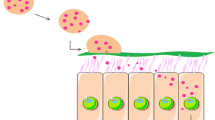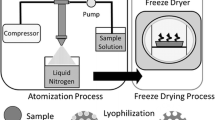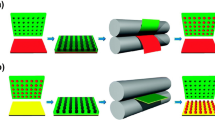Abstract
Purpose. Relatively large (>5 µm) and porous (mass density < 0.4 g/cm3) particles present advantages for the delivery of drugs to the lungs, e.g., excellent aerosolization properties. The aim of this study was, first, to formulate such particles with excipients that are either FDA-approved for inhalation or endogenous to the lungs; and second, to compare the aerodynamic size and performance of the particles with theoretical estimates based on bulk powder measurements.
Methods. Dry powders were made of water-soluble excipients (e.g., lactose, albumin) combined with water-insoluble material (e.g., lung surfactant), using a standard single-step spray-drying process. Aerosolization properties were assessed with a Spinhaler TM device in vitro in both an Andersen cascade impactor and an AerosizerTM..
Results. By properly choosing excipient concentration and varying the spray drying parameters, a high degree of control was achieved over the physical properties of the dry powders. Mean geometric diameters ranged between 3 and 15 µm, and tap densities between 0.04 and 0.6 g/cm3. Theoretical estimates of mass mean aerodynamic diameter (MMAD) were rationalized and calculated in terms of geometric particle diameters and bulk tap densities. Experimental values of MMAD obtained from the AerosizerTM most closely approximated the theoretical estimates, as compared to those obtained from the Andersen cascade impactor. Particles possessing high porosity and large size, with theoretical estimates of MMAD between 1−3 µm, exhibited emitted doses as high as 96% and respirable fractions ranging up to 49% or 92%, depending on measurement technique.
Conclusions. Dry powders engineered as large and light particles, and prepared with combinations of GRAS (generally recognized as safe) excipients, may be broadly applicable to inhalation therapy.
Similar content being viewed by others
REFERENCES
A. J. Hickey (ed.). Inhalation aerosols—Physical and biological basis for therapy, in Lung Biology in Health and Disease, C. Lenfant (ex. ed.) 94, 1996.
M. P. Timsina, G. P. Martin, C. Marriot, D. Ganderton, and M. Yianneskis. Drug delivery to the respiratory tract using dry powders inhalers. Int. J. Pharm. 101:1–13 (1994).
D. L. French, D. A. Edwards, and R. W. Niven. The influence of formulation on emission, deaggregation and deposition of dry powders for inhalation. J. Aerosol Sci. 27:769–783 (1996).
W.-I. Li, M. Perzl, J. Heyder, R. Langer, J. D. Brain, K.-H. Englmeier, R. W. Niven, and D. A. Edwards. Aerodynamics and aerosol particle deaggregation phenomena in model oral-pharyngeal cavities. J. Aerosol Sci. 27:1269–1286 (1996).
D. A. Edwards, J. Hanes, G. Caponetti, J. Hrkach, A. Ben-Jebria, M. L. Eskew, J. D. Mintzes, D. Deaver, N. Lotan, and R. Langer. Large porous particles for pulmonary drug delivery. Science 276:1868–1871 (1997).
A. Ben-Jebria, D. Chen, M.-L. Eskew, R. Vanbever, R. Langer, and D. A. Edwards. Inhalation of large porous albuterol particles for sustained bronchodilation. Pharm. Res. 16:555–561 (1999).
J. Wang, A. Ben-Jebria, and D. A. Edwards. Inhalation of estradiol for sustained systemic delivery J. Aerosol Med. 12:27–32 (1999).
R. Vanbever, A. Ben-Jebria, J. D. Mintzes, R. Langer, and D. A. Edwards. Sustained-release of insulin from insoluble inhaled particles. Intern. Symp. Control. Rel. Bioact. Mater. 25:261–262 (1998).
European Pharmacopoeia, 3rd edition, addendum 1999, 74–77.
I. Gonda. Topics in Pharmaceutical Sciences 1991, D. J. A. Crommelin and K. K. Midha (eds), Medpharm Scientific, Stuttgart, 1992.
H. Brenner and D. A. Edwards, Macrotransport Processes, Butterworth-Heinemann, 1993.
K. Masters Spray drying handbook (5th. ed.), Longman Scientific and Technical, 1991.
M. Sacchetti and M. M. Van Oort. Spray-drying and supercritical fluid particle generation techniques. In: A. J. Hickey (ed), Inhalation Aerosols, Marcel Dekker, 1996, 337–384.
J. D. Andya, Y.-F. Maa, H. R. Costantino, P.-A. Nguyen, N. Dasovich, T. D. Sweeney, C. C. Hsu, and S. J. Shire. The effect of formulation excipients on protein stability and aerosol performance of spray-dried powders of a recombinant humanized anti-IgE monoclonal antibody. Pharm. Res. 16:350–358 (1999).
A. R. Clark and M. Egan. Modelling and deposition of inhaled powders drug aerosols. J. Aerosols Sci. 25:175–186 (1994).
E. Mathiowitz, H. Bernstein, S. Giannos, P. Dor, T. Turek, and R. Langer. Polyanhydride microspheres. IV. Morphology and characterization of systems made by spray drying, J. Appl. Poly. Sci. 45:125–134 (1992).
Y.-F. Maa, P.-A. Nguyen, and S. W. Hsu. Spray drying of airliquid interface sensitive recombinant human growth hormone. J. Pharm. Sci. 87:152–159 (1998).
X. M. Zeng, G. P. Martin, and C. Marriot. Albumin microspheres as a means of drug delivery to the lung: analysis of the effects of process variables on particle sizes using factorial design methodology. Int. J. Pharm. 107:205–210 (1994).
X. M. Zeng, G. P. Martin, and C. Marriot. Tetrandrine delivery to the lung: The optimisation of albumin microspheres preparation by central composite design, Int. J. Pharm. 109:135–145 (1994).
J. A. Clements and R. J. King. Composition of the surface active material. In: R. G. Crystal (ed.), The Biochemical Basis of Pulmonary Function, Marcel Dekker, Inc, 1976, chap 10.
S. I. Rennard, G. Basset, D. Lecossier, K. M. O'Donnell, P. Pinkston, P. G. Martin, and R. G. Crystal. Estimation of volume of epithelial lining fluid recovered by lavage using urea as marker of dilution. J. Appl. Physiol. 60:532–538 (1986).
N. J. Toremalm. The daily amount of tracheo-bronchial secretions in man. Acta Oto-laryng. (suppl.) 158:43–53 (1960).
J. S. Patton. Mechanisms of macromolecule absorption by the lungs. Adv. Drug Del Rev. 19:3–36 (1996).
E. R. Weibel. Morphometry of the Human Lung, New York Academic Press, 1963.
R. J. Mason and M. C. Williams. Alveolar type II cells. In: R. G. Crystal, J. R. West et al (eds), The lung: scientific foundations, New York Raven Press Ltd, 1991, Chap. 3.1.9.
G. Scheuch, T. Meyer, K. Sommerer, H. Lichte, A. Pohner, W. Hess, P. Brand, G. Caponetti, K. Haussinger, J. Heyder, R. Batycky, R. Niven, and D. A. Edwards. Measuring in vivo deposition of large porous particles. Presented at the Biannual ISAM Meeting, Vienna, June 12–16, 1999).
Author information
Authors and Affiliations
Corresponding author
Rights and permissions
About this article
Cite this article
Vanbever, R., Mintzes, J.D., Wang, J. et al. Formulation and Physical Characterization of Large Porous Particles for Inhalation. Pharm Res 16, 1735–1742 (1999). https://doi.org/10.1023/A:1018910200420
Issue Date:
DOI: https://doi.org/10.1023/A:1018910200420




